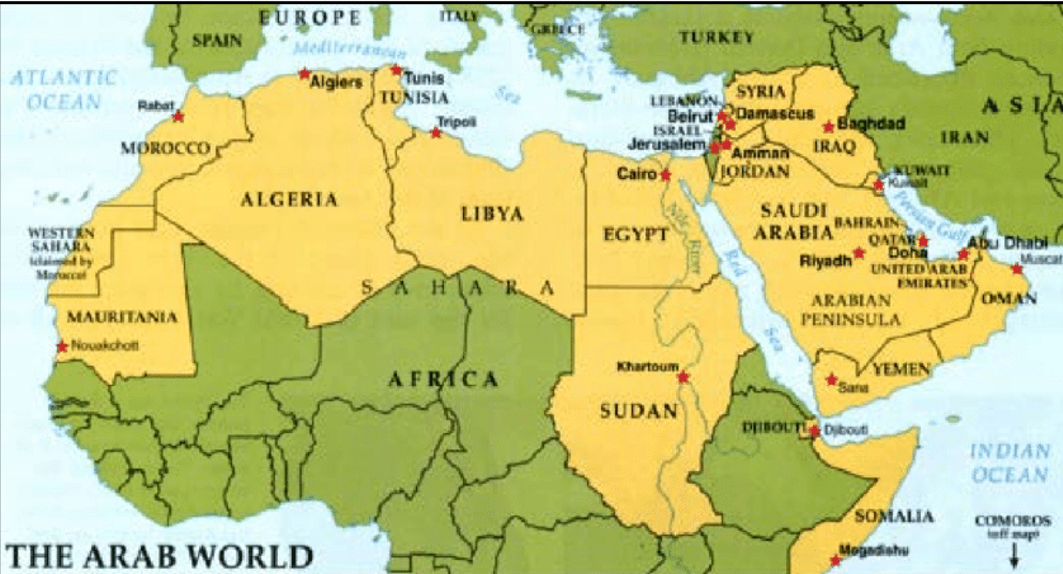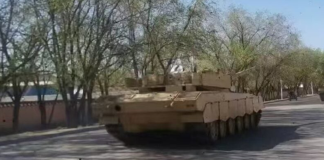By Serafeim Vylliotis
The Arab culture appeared on the scene in the 7th century and by the 8th century had spread to three continents. In the Middle Ages it was more dynamic and powerful than Christian culture, with which it was in competition. Only Chinese culture, which was introverted, could claim to be its equal. But in the 15th century, the Arabs were expelled from Europe.
In the 16th century, the Ottomans imposed themselves on the Middle East and the Arabs, while retaining a degree of autonomy, lived under Ottoman rule for four centuries. In the 19th and 20th centuries, France, Great Britain and Italy turned their colonies in North Africa into their protectorate. During World War I, when the Ottoman Empire allied with Germany, most Arabs sided with the Allies hoping to gain independence.
The ongoing Israeli-Palestinian conflict and the non-establishment of a Palestinian state mobilize public opinion in the Arab world (but not their governments.) Some regimes have long instrumentalized the Palestinian issue to cover up their internal democratic and social deficits, while Islamists do the same for their own reasons. The war in Iraq has further contributed to radicalization and frustration. The democratization imposed From the outside he proved weak or adventurous. The Arab world is deeply divided and weakened. The « Arab Spring » died out quickly or failed: Iraq, Syria, Libya, Yemen and Egypt were plunged into violence and lost much of their power. In Tunisia, authoritarianism is now returning.)
MASHREK: A chaotic zone?
The Mashreq (“Levant”) is the eastern side of the Arab world. It consists of Egypt, Jordan, Iraq, Lebanon, Syria and the region of Palestine. Unlike the Maghreb, many religions coexist in the Mashreq. The area was historically marked by the Sykes-Picot Agreements, named after the English and French diplomats who after World War I divided territories of the defeated Ottoman Empire into spheres of influence. Under orders from the League of Nations (League), France took control of Lebanon and Syria, while England took control of Iraq, Transjordan and Palestine.
EGYPT: A weakened large country
Egypt unilaterally declared independence in 1922, but remained effectively under British control. Apart from the Arab world’s declarations of unity and failed plans to form a confederation (United Arab Republic (1956-1961), Jordanian-Iraqi Union (1958)), the Mashreq was fragmented politically, strategically, and religiously. (EXAMPLE: EGYPT: celebrations with Saudi flags).
In 1954, Colonel Gamal Abdel Nasser became Egypt’s strongman and pursued a nationalist policy. His popularity spread far beyond his country’s borders after the nationalization of the Suez Canal in 1956. Egypt moved closer to the USSR, but after the 1973 war, his successor, Anwar Sadat, realized that his alliance with Moscow did not allow him to recover the Sinai Peninsula, occupied by Israel in 1967, so he approached Washington and signed a separate peace with Israel (Camp David Agreement 1978), which led to exclusion from the Arab League. The alliance with Washington (which granted economic and military aid to Egypt) became an important axis of Egyptian policy.
The deadly popular uprisings in February 2011 toppled Hosni Mubarak, who had been in power since 1981. Free presidential elections were held for the first time in 2012. Muslim Brotherhood candidate Mohamed Morsi emerged victorious but was overthrown in a violent coup by General Abdel Fattah al-Sisi in July 2014, restoring dictatorship.
Egypt, for the strategic planning of the West, occupies a central strategic position.
Syrian and Iraqi Chaos
In Iraq and Syria, which became independent in 1932 and 1946 respectively, power was seized by the Baath Party, described as secular, nationalist and pan-Arab. Despite these common features and ties to Moscow, the two countries were the region’s “irreconcilable friends.” In Iraq, power was seized by a strongman, Saddam Hussein, from the Sunni minority (17% of the population, about as much as the Kurds). In Syria, the leader was the Alawite (minority 10% of the population – close to Shiism) Hafez al-Assad, who allied with Iran during the war against Iraq (1980-1988). Syria has a strongly hostile attitude towards Israel, but this remains only verbal.
Iraq was exhausted by the wars started by Saddam Hussein (against Iran and then Kuwait), the Western embargo of 1991-2003 and the wars with the West (1991, 2003). Now the country’s population is complaining about foreign manipulation and corruption of politicians.
In Syria, Bashar al-Assad, who succeeded his father in 2000, faced peaceful protests from people demanding democracy and social justice. He responded with blind repression. Thus, with the intervention of foreign powers, a fierce civil war began, which led to the radicalization of part of the opposition and facilitated the consolidation of the jihadists. The war became internationalized: Arab countries and Turkey opposed to Bashar al-Assad went so far as to support radical groups. Westerners condemned the regime’s atrocities without providing real help to the rebels, while Russia and Iran supported the Syrian regime.
Sunni jihadists founded the Islamic State in territories in Iraq and Syria (about 200,000 square kilometers) and declared the abolition of the Sykes-Picot Accords, exploiting the discontent of Sunnis who were excluded from high office in Iraq and mistreated by the Syrian regime. Thus, an international coalition was formed in which supporters and opponents of the Syrian regime came together to dismantle the Islamist organization. Bashar al-Assad remains in power thanks to the support of Russia and Iran, even though his country has been destroyed. The war has left more than 500,000 dead and half the population has been forced to flee.
Lebanon, Jordan: Surviving through Hardship
LEBANON
Damascus has never accepted the independence of Lebanon, which it considers part of a “greater Syria.” As we said before, Lebanon is an artificial creation of the West to block Syria’s exit to the Mediterranean. Maintaining a fragile balance between 18 religious communities, Lebanon has been destabilized by the many flows of Palestinian refugees. In 1975, civil war broke out. At the request of Christians, Syria intervened and expanded its influence in the country. After the Israeli intervention in 1982, the Shiites, the largest and poorest community, organized around Hezbollah, a military and political organization supported, as mentioned above, by Iran. After the assassination of Sunni Prime Minister Rafik Hariri, attributed to the Syrian regime, a UN resolution backed by France and the US forced Syria to withdraw from Lebanon. The country currently hosts 1.5 million Syrian refugees and in combination with the Palestinians creates a situation of complete instability and imbalance. With the Israeli army’s incursion into the south of Lebanon, where its forces are operating against Hezbollah, it is now clear that the Lebanese government is playing only a cosmetic role. Corruption and criminality are very high on the indicators with a growing trend.
JORDAN
Jordan, where the majority population is of Palestinian origin, is another Arab country that has signed a peace treaty with Israel. The country relies on its relationship with Washington to ensure its security and monarchy.
The Mashreq once had three relatively powerful countries with stable state structures and international weight: Egypt, Syria and Iraq. The first is now in poor condition and the other two have to be rebuilt from scratch. Lebanon is currently in the same fate as Syria. Jordan has so far managed to avoid the worst.













